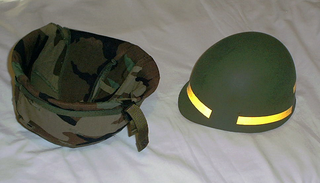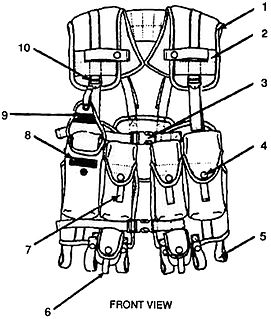
A climbing harness is an item of climbing equipment for rock-climbing, abseiling, or other activities requiring the use of ropes to provide access or safety such as industrial rope access, working at heights, etc. A harness secures a person to a rope or an anchor point.

Webbing is a strong fabric woven as a flat strip or tube of varying width and fibres, often used in place of rope. It is a versatile component used in climbing, slacklining, furniture manufacturing, automobile safety, auto racing, towing, parachuting, military apparel, load securing, and many other fields.

MOLLE is an acronym for Modular Lightweight Load-carrying Equipment. It is used to define the current generation of load-bearing equipment and backpacks used by a number of NATO armed forces, especially the British Army and the United States Army.

A baseball glove or mitt is a large leather glove worn by baseball players of
the defending team, which assists players in catching and fielding balls hit by a batter or thrown by a teammate.

The M1 helmet is a combat helmet that was used by the United States military from World War II until 1985, when it was succeeded by the PASGT helmet. For over forty years, the M1 was standard issue for the U.S. military. The M1 helmet has become an icon of the American military, with its design inspiring other militaries around the world.

A jerkin is a man's short close-fitting jacket, made usually of light-coloured leather, and often without sleeves, worn over the doublet in the sixteenth and seventeenth centuries. The term is also applied to a similar sleeveless garment worn by the British Army in the 20th century.
Personal Load Carrying Equipment (PLCE) is one of several current tactical webbing systems of the British Armed Forces. Dependant upon the year of design, and the decade of introduction, the webbing system was designated, and is commonly referred to, as either the 85 Pattern, the 90 Pattern or the 95 Pattern webbing.

A sling or runner is an item of climbing equipment consisting of a tied or sewn loop of webbing. These can be wrapped around sections of rock, hitched to other pieces of equipment, or tied directly to a tensioned line using a Prusik style knot. They may be used as anchors, to extend an anchor to reduce rope drag, in anchor equalization, or to climb a rope.
Blanco was a compound used primarily by soldiers throughout the Commonwealth from 1880 onwards to clean and colour their equipment. It was first used by the British Army to whiten Slade Wallace buckskin leather equipment, and later adapted to coloured versions for use on the cotton Web Infantry Equipment, Pattern 1908 webbing. Blanco became widely used throughout both world wars.

The Denison smock was a coverall jacket issued to Special Operations Executive (SOE) agents, the Parachute Regiment, the Glider Pilot Regiment, Air Landing Regiments, Air Observation Post Squadrons, Commando units, and other Commonwealth airborne units, to wear over their Battle Dress uniform during the Second World War.

The IIFS was introduced in 1988, to serve as a fighting and existence carrying system - a possible replacement for the All-Purpose Lightweight Individual Carrying Equipment (ALICE) employed and fielded by United States Armed Forces since 1973.

The Pouch Attachment Ladder System or PALS is a grid of webbing invented and patented by United States Army Natick Soldier Research, Development and Engineering Center used to attach smaller equipment onto load-bearing platforms, such as vests and backpacks. It was first used on MOLLE rucksacks, but is now found on a variety of tactical equipment, such as the American Improved Outer Tactical Vest, Interceptor body armor, USMC Improved Load Bearing Equipment backpack and Modular Tactical Vest. It is used to attach items such as holsters, magazine pouches, radio pouches, knife sheathes, and other gear. A wide variety of pouches are commercially available, allowing soldiers to customize their kit. There is also a variety of attachment methods including the Alice Clip, the Natick snap, and soft, interwoven straps. The PALS system has begun to be adopted by other forces, such as the British Army, who use it on their Osprey body armour.

1937 Pattern Web Equipment was an item of military load-carrying equipment. It replaced the 1908 Pattern and 1925 Pattern—on which it was based—and was standard issue for British and Commonwealth troops from its introduction in 1937, throughout World War II, and in the post-war period until it was superseded by 58 pattern webbing.
Interdigital webbing is the presence of membranes of skin between the digits. Normally in mammals, webbing is present in the embryo but resorbed later in development, but in various mammal species it occasionally persists in adulthood. In humans, it can be found in those suffering from LEOPARD syndrome and from Aarskog-Scott syndrome.
The 1972 Pattern Webbing was intended to replace the 58 pattern webbing, but never got beyond user trials. It was made from PU-coated nylon to counter the Soviet NBC capability with a general look closer to a load-bearing vest. It was designed to be used in wide variety of environments such as jungles, deserts and was configurable for use, ranging from short-duration jungle patrols to general infantry use.
The 1939 pattern webbing was an item of military load-carrying equipment used in the Second World War. It was a leather variant of the 1937 pattern web equipment.
The 1914 Pattern Web Equipment was the webbing issued to the British Army during World War I.

The 1908 Pattern Web Infantry Equipment was an innovative type of webbing equipment adopted by the British Army before World War I.













